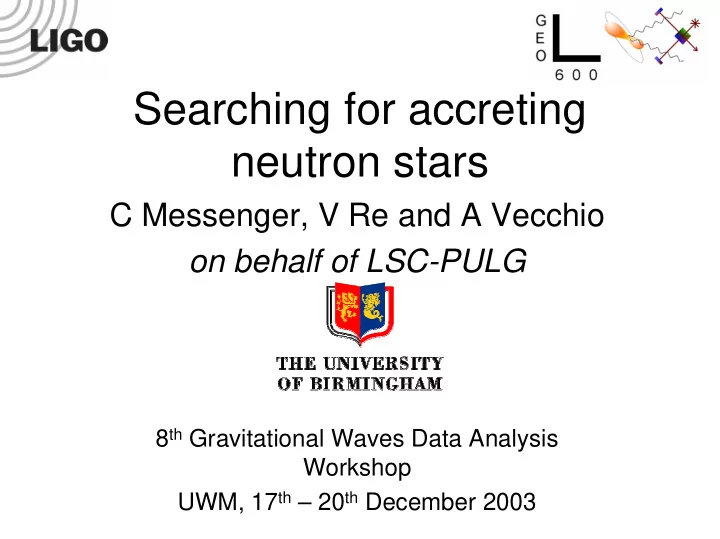

Searching for accreting neutron stars C Messenger, V Re and A Vecchio on behalf of LSC-PULG 8 th Gravitational Waves Data Analysis Workshop UWM, 17 th – 20 th December 2003
Outline • Astrophysical scenario • Data analysis – General – Approach for LIGO S2 data set • Work in progress and future plans GWDAW8, 17 th – 20 th December 2003 A Vecchio – Accreting neutron stars
Astrophysical scenario • Observational evidence that rotation frequencies in Low Mass X-Ray Binaries (LMXB) are – Well below NS breaking frequency – Clustered in a narrow (237 Hz – 619 Hz) frequency range (Bildsten, 1998; Chakrabarty et al, 2003) • Currently, two are the proposed mechanisms: – Magnetic braking (Wang and Zang, 1997), but need for fine tuning of parameters – Gravitational waves (Bildsten, 1998) GWDAW8, 17 th – 20 th December 2003 A Vecchio – Accreting neutron stars
GWs from accreting neutron stars • Conjecture for LMXBs: GWs are the limiting physics that prevents NSs from being spun-up to the braking frequency – Two models: 1. Density fluctuations – “mountain” on neutron star (Bildsten, 1998; Ushomirsky, Cutler, Bildsten, 2000; Cutler, 2002) – f gw = 2 f rot 2. R-modes (Andersson et al, 1999; Wagoner, 2002) – f gw = 4/3 f rot (from Cutler and Thorne 2000) GWDAW8, 17 th – 20 th December 2003 A Vecchio – Accreting neutron stars
Data analysis • Source position: known • Orbital motion – Circular orbit to a very good approximation – Search with discrete mesh over 3 orbital parameters (period, projected orbit semi-major axis, initial phase) – Phase Doppler shift much more severe than for isolated sources P: binary period q = m 2 /m NS • Signal confined to a single bin for T obs < 150 sec (Sco X-1) • . ∆ f ~ 0.2 Hz (Sco X-1) GWDAW8, 17 th – 20 th December 2003 A Vecchio – Accreting neutron stars
Data analysis (cont’d) • Intrinsic change in GW frequency (“spin down”) – System is in equilibrium – GW emission balances accretion torque: frequency makes a “random walk” as the accretion rate (Mdot) changes in time – We can not model this frequency evolution using low-order polinomial in time – However, the signal is confined to a single frequency by for T obs < 2 weeks τ : time scale over which torque doubles or turns off • Rotation frequency, and therefore GW frequency, not very well known : ∆ f ~ 1 – 40 Hz GWDAW8, 17 th – 20 th December 2003 A Vecchio – Accreting neutron stars
Computationally bound search • Computational load comes from two poorly constrained set of parameters: – Emission frequency: search over a fairly large bandwidth (tens of Hz) – Orbital parameters (Sco X-1: N_filt ~ 10 6 for 1 day of coherent integration) – Long integration times • Search strategy: – Hierarchical : simplest approach is to use a “stack-slide” search (Brady and T Creighton, 1999) • Coherent integration over T c • Concatenate incoherently M chunks of length T c (total observation time = M T c ) – Stack-slide search code development is well underway GWDAW8, 17 th – 20 th December 2003 A Vecchio – Accreting neutron stars
Approach for S2 analysis • Target Sco X-1 (the brightest source) – The analysis can be extended in a straightforward way (in principle) to the other LMXBs • Only coherent analysis (the core of the entire search strategy) over: – Relevant band for emission at twice the rotation frequency (but if enough processing power is available we’ll explore band for 4/3 rotation frequency) – The longest possible observation time for available computational resources (Tsunami: 200 CPUs) T (coherent) < 1/2 day • Frequency domain analysis (different flavour of analysis carried out for S1) GWDAW8, 17 th – 20 th December 2003 A Vecchio – Accreting neutron stars
Scorpius X-1 • Neutron star in a binary system accreting from a low- mass (0.42 M_sun) companion – Distance: 2.8 (+/- 0.2) kpc – Orbital parameters • Period: 0.787313(1) day = 18.9 hrs • Projected semi-major axis: 1.990 sec < a < 2.213 sec • “Initial” orbital phase: ∆α = 0.1 rad • Circular orbit (e < 10 -3 ) – Rotation frequency from twin kHz QPOs (van der Klis et al, 1997; van der Klis, 2000) • 232 – 242 Hz • 302 – 312 Hz GWDAW8, 17 th – 20 th December 2003 A Vecchio – Accreting neutron stars
S2 analysis in progress • One-stage coherent FD analysis (F statistic) • T obs = 6 hrs – Same data segment for L1, H1 and H2 • Search carried out over: – Wide frequency band 1. “lower band”: 464 – 484 Hz 2. “upper band”: 604 – 624 Hz – Discrete mesh over 2D parameter space (10% mismatch) • Period known to high accuracy (not a search parameter for T obs < 1 month) Mesh on a and α: 39,487 filters (upper-band) • • Frequentist upper-limits on the relevant frequency range GWDAW8, 17 th – 20 th December 2003 A Vecchio – Accreting neutron stars
Limit on integration time • 3 detectors • Sco X-1 parameters • 40 Hz bandwidth Tsunami 200 CPUs GWDAW8, 17 th – 20 th December 2003 A Vecchio – Accreting neutron stars
Conclusions • Coherent search analysis pipeline is in place • S2 analysis is in progress • However, sensitivity improvements rely on hierarchical search approach (well underway – dedicated effort for “stack-slide” in PULG by Landry & Mendell) • Future plans – Full stack-slide analysis code ready for S3 analysis – Place upper-limits on other accreting neutron stars – Place upper-limits on emission at 4/3 f rot GWDAW8, 17 th – 20 th December 2003 A Vecchio – Accreting neutron stars
Recommend
More recommend